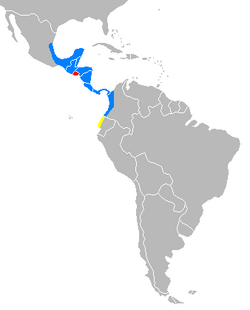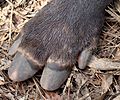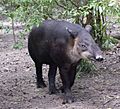Baird's Tapir facts for kids
Quick facts for kids Baird’s Tapir |
|
|---|---|
 |
|
| Conservation status | |
| Scientific classification | |
| Kingdom: | |
| Phylum: | |
| Class: | |
| Order: | |
| Family: | |
| Genus: | |
| Species: |
T. bairdii
|
| Binomial name | |
| Tapirus bairdii (Gill, 1865)
|
|
 |
|
| Distribution of Baird’s Tapir is shown in blue In red, El Salvador, where it is extirpated. In yellow, Ecuador, presence is unconfirmed. |
|
The Baird’s Tapir (Tapirus bairdii) is a fascinating animal that lives in the dense jungles of Central and northern South America. It is one of four types of tapirs found in Latin America. These amazing creatures are known for their unique snout, which looks a bit like a short elephant trunk!
Baird’s Tapirs are found in places like southeastern Mexico, Belize, Guatemala, Honduras, Costa Rica, Nicaragua, Panama, and Colombia. They might also live in Ecuador, but this is not fully confirmed. These tapirs can live in high places, sometimes as high as 3,350 meters (10,990 feet) above sea level!
Contents
What is a Tapir?
Tapirs are large, plant-eating mammals. They are related to horses and rhinoceroses, even though they look quite different. Tapirs have a sturdy body, short legs, and a very special snout. This snout is actually a flexible nose and upper lip that they can move around.
Physical Features
Baird's Tapirs are the largest land mammals in Central America. They can weigh between 240 and 400 kilograms (530 to 880 pounds). They stand about 1.2 meters (4 feet) tall at the shoulder. Their fur is usually dark brown or grayish-brown. They have a creamy white patch on their chest and throat.
Their most noticeable feature is their long, flexible snout. They use this snout to grab leaves and fruit. Young tapirs, called calves, have a different look. They are born with stripes and spots, which help them hide in the jungle. These markings fade as they grow older.
Where They Live
Baird's Tapirs prefer to live in thick forests and jungles. They like areas near water, such as rivers and swamps. Water is very important for them. They often cool off by swimming or wallowing in mud. This also helps protect them from insects.
They are mostly active at night, which means they are nocturnal. During the day, they usually rest in hidden spots in the forest. They are shy animals and prefer to stay away from humans.
What Do They Eat?
Baird's Tapirs are herbivores, meaning they only eat plants. Their diet includes a wide variety of leaves, twigs, flowers, and fruits. They use their strong jaws and teeth to chew tough plant material. Their flexible snout helps them pick ripe fruits and pluck leaves from branches. They are very important for the forest because they help spread seeds as they move around and eat.
Conservation Status
Sadly, the Baird’s Tapir is an endangered species. This means their numbers are decreasing, and they face a high risk of extinction. The biggest threats to these tapirs are:
- Habitat Loss: Forests are being cut down for farming, logging, and human settlements. This leaves tapirs with less space to live and find food.
- Hunting: In some areas, tapirs are hunted for their meat.
- Roads: New roads can cut through their habitats, making it harder for them to move safely.
Many groups are working to protect Baird's Tapirs. They are trying to save their habitats and educate people about why these animals are important. Protecting tapirs also helps protect the entire jungle ecosystem they live in.
See also
- In Spanish: Tapir centroamericano para niños
Images for kids
-
A Baird's tapir skull on display at the Museum of Osteology, Oklahoma City, Oklahoma






